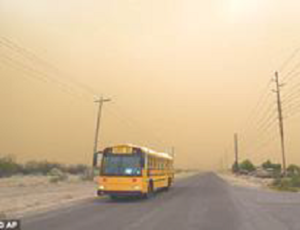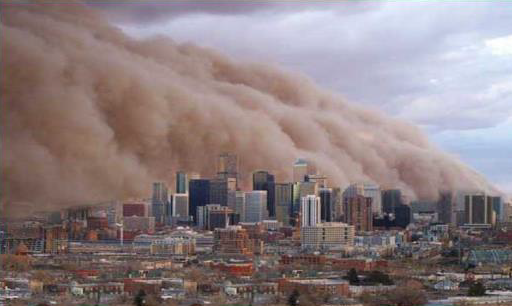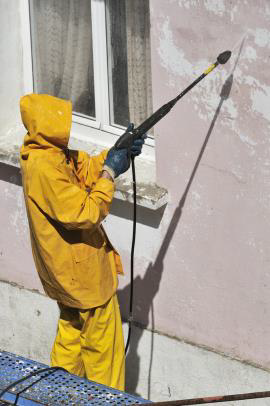Call (602) 253-6200 for More Information or a No Obligation Quote
Schools and Improved Air Quality

Air quality is a concern in Arizona schools due in part to the age and poor condition of many school buildings but also due to Arizona’s dry, hot climate – which impacts student lives both inside and outside of school buildings. Managing schools involves the responsibility for public funds and child safety/health issues. Frequently, schools have a large number of heating, ventilating, and air-conditioning equipment, which places added strain on maintenance staff – changing filters, cleaning dusted areas, etc. The outside air drastically impacts the inside air quality and the use of heating/cooling equipment.
The Environmental Protection Agency addresses air quality concerns in its “Healthy Schools” programs and provides tools to assess and fix air quality problems. However, Arizona and the southwest has a specific list of air concerns that are not a national issue. Arizona school age kids face many obstacles and hardships – exhausting heat, crime, drugs, and gangs to name a few. In Arizona, there is another hazard: breathing. Our extreme climate turns out to be extremely hospitable to the Coccidiosis fungus, the agent that causes Valley Fever. Our kids are exposed to it daily without warning.
 Valley Fever is a systemic infection. Victims are exposed by breathing in fungal spores, often after a period of high winds. Not everyone who is exposed develops the disease. Many report flu-like symptoms, including fever, cough, headache, muscle aches and fatigue. In other cases, Valley Fever causes serious lung infections, pneumonia, and even death. Children with asthma or allergies are especially vulnerable. It’s time to recognize this threat!
Valley Fever is a systemic infection. Victims are exposed by breathing in fungal spores, often after a period of high winds. Not everyone who is exposed develops the disease. Many report flu-like symptoms, including fever, cough, headache, muscle aches and fatigue. In other cases, Valley Fever causes serious lung infections, pneumonia, and even death. Children with asthma or allergies are especially vulnerable. It’s time to recognize this threat!
Arizonans Are at Greater Risk
The coccidiosis fungus can be found in the soil and dust in the Southwest. The highest concentration is in Arizona, which had twice as many cases of Valley Fever in 2012 than any other state. According to the CDC, almost 75 percent of Valley Fever victims miss work or school. Up to 40 percent must be hospitalized, at an average cost of nearly $50,000. For schools, this presents a reduced attendance count. Federal funding supports more than half of the educational costs in Arizona and is based upon the attendance number.
 It is not just a matter of knowing what is in the soil. Summer dust storms bring contaminated dust from wide areas. The fungus can coat homes, roofs, schools, playgrounds, and anything else that is exposed to the air. Normal outdoor play activities also stir up the dust, making it impossible for children to avoid breathing it in.
It is not just a matter of knowing what is in the soil. Summer dust storms bring contaminated dust from wide areas. The fungus can coat homes, roofs, schools, playgrounds, and anything else that is exposed to the air. Normal outdoor play activities also stir up the dust, making it impossible for children to avoid breathing it in.
Keeping Our Kids Safe
Protecting our children from an airborne danger is difficult. If possible, everyone – especially children – should stay indoors during a dust storm or high winds. Once the storm passes, it leaves dust everywhere and much of this dust contains the Valley Fever fungus spores.

There is a better way to protect our school age children. Pressure washing, followed by regular high pressure misting, can keep the fungus out of the air. Valley Fever fungus is hardy. Cleaning must be done using high-pressure washers and specific nontoxic solutions which are microbial in nature. The same care should be taken when spraying the ground around the school. Treatments should be repeated as necessary, especially after a Haboob. PSI-MistAir can provide this service or instruct school maintenance employees on these procedures, equipment, and solutions.
Schools wishing to implement these precautions should contact Pressure Systems Inc. – an expert pressure washing company to learn what chemical solutions to use and which pressure washing equipment will perform best at their site. Any outdoor area can be equipped with a misting system (purchased or rented), whether it is a large sports complex, playgrounds, or a school’s outdoor walkways.
Misting helps to inhibit respiratory illnesses such as colds, flues, pneumonia, bronchitis, asthma, allergies, and yes even Valley Fever.
It dramatically reduces dust, pollen, insects, odors, and other air borne contaminates.
Central and Southern Arizona has a humidity that is less than 14%. Normal humidity for humans is above 40%. Misting produces needed moisture for healthy students.
Misting can reduce the immediate temperatures by 20 to 30 degrees.
